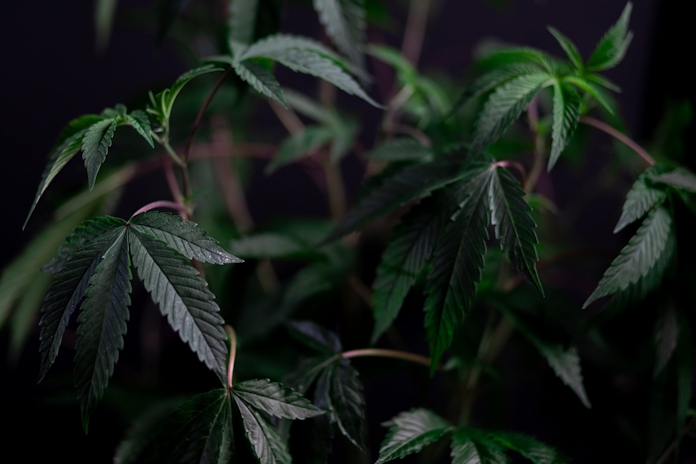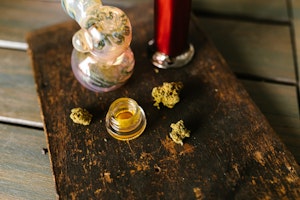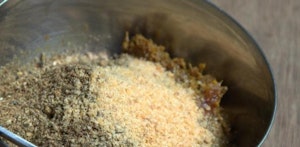
Photo by Kindel Media / Pexels
6 Ways To Use Cannabis Leaves
Cannabis plants are a treasure trove of utility, right from their potent buds down to the fan leaves.
Though often discarded, these leaves can be used in multiple ingenious ways. If you’ve wondered how to repurpose your cannabis fan leaves, this article explores six potential uses.
While many focus on the buds—the primary source of THC and CBD—it’s essential to understand that the leaves harbor potential beyond mere aesthetics. From their role in the plant’s health to their varied applications, cannabis fan leaves are a hidden gem in the vast landscape of marijuana products.
Suppose you’ve been discarding these leaves or are simply curious about their potential uses. In that case, this article will illuminate the myriad ways in which cannabis fan leaves can be both beneficial and versatile.
Why Are Fan Leaves Important?

Image by darren415 / Adobe Stock
Fan leaves are not just an accessory; they play a pivotal role in the life and health of a cannabis plant. Think of them as the vital organs responsible for keeping the plant alive, thriving, and robust.
To begin with, fan leaves are the primary photosynthetic organs of the cannabis plant. Acting like nature’s solar panels, these leaves absorb sunlight and undergo a process known as photosynthesis.
Through this, they convert light energy into chemical energy, producing glucose—a sugar that the plant uses for sustenance and growth. Without healthy fan leaves, the plant would be starved of this crucial energy, leading to stunted growth or even death.
Furthermore, fan leaves serve as the plant’s barometer, hinting at its overall health. Observant cultivators often scrutinize fan leaves for signs of distress. Changes in their color, shape, or size can indicate potential issues such as nutrient deficiencies, overwatering, or the onset of diseases. Early detection of these signals can mean the difference between a flourishing crop and a failed one.
Besides being a health indicator, fan leaves have evolved as a protective shield against external threats. Their expansive surface area deters many pests, such as aphids and caterpillars, which might otherwise damage the more delicate parts of the plant. Moreover, the leaves’ stomata—tiny pores on their surface—aid in respiration and transpiration, a process that helps regulate the plant’s temperature and internal water balance.
In essence, fan leaves are not mere appendages. They are the hardworking guardians and sustainers of the cannabis plant, ensuring it remains healthy, productive, and capable of producing the high-quality buds that consumers and medical patients alike have come to value.
Do Fan Leaves Contain Cannabinoids?
The spotlight in cannabis discussions often shines on the plant’s buds, hailed for their rich concentration of cannabinoids, the compounds responsible for the plant’s therapeutic and psychoactive effects. However, fan leaves, although more modest in their offerings, are not entirely devoid of these potent compounds.
It’s essential to understand that while the buds glitter with resinous trichomes packed with cannabinoids, fan leaves contain these compounds in trace amounts. The concentration is less than what you’d find in the colas or the more resinous “sugar” leaves that surround the buds.
Historical studies, such as a 1971 United Nations report, suggested that fan leaves might contain up to 0.3% THC and 0.7% CBD. However, this data derived from a limited sample size spanning various geographical regions. And, indeed, not all samples showed detectable levels of THC.
Fast-forward to the present, and the cannabis landscape has transformed drastically. Selective breeding and enhanced cultivation techniques have given rise to strains with considerably higher cannabinoid concentrations than their historical counterparts. While this primarily affects the buds, it’s conceivable that contemporary fan leaves might boast slightly higher cannabinoid levels than those of past eras.
However, it’s crucial to set realistic expectations. If you’re considering utilizing fan leaves for their cannabinoid content, remember that their contribution remains humble compared to other parts of the plant. But their presence underscores the holistic nature of cannabis, where every part, from the sturdy stem to the expansive fan leaf, plays its unique role in the plant’s life cycle and potential uses.
Fan Leaves Vs. Sugar Leaves

Photo by hanohiki / Adobe Stock Photo
Cannabis aficionados often find themselves in the fan leaves versus sugar leaves debate. While both are part of the cannabis plant, there are distinct differences. Sugar leaves, smaller than fan leaves, are usually covered in shiny trichomes, which are rich in cannabinoids.
Their name “sugar” is derived from their crystalline appearance, resembling powdered sugar. Due to their higher cannabinoid content, sugar leaves are more sought after compared to fan leaves. However, this doesn’t mean fan leaves don’t have their unique applications, as we’ll see below.
Cannabis is a multifaceted plant, with each component having its unique characteristics and purposes. Two types of leaves play pivotal roles in the life of the cannabis plant: fan leaves and sugar leaves. Understanding the distinctions between them helps cultivators make informed decisions about their cultivation practices and utilization post-harvest.
Morphology and Location
Fan leaves are the iconic, large leaves often depicted in cannabis imagery. Their expansive structure is not merely for show; these leaves act as the plant’s primary photosynthetic engines, capturing sunlight and converting it into the energy needed for growth.
Sugar leaves, on the other hand, are smaller leaves nestled among the cannabis buds or colas. They earn their sweet moniker due to the sugary-looking trichomes that coat them. Unlike the broader fan leaves, sugar leaves are more intricately associated with the buds, providing a protective layer.
Cannabinoid and Terpene Content
While both leaf types contain cannabinoids, the concentrations differ considerably. Fan leaves possess trace amounts, as previously discussed. Their primary role is not to be reservoirs of cannabinoids but to support the plant’s growth through photosynthesis.
Sugar leaves, however, are a different story. Their proximity to the buds and the presence of resin-bearing trichomes mean they have a higher concentration of cannabinoids and terpenes. This composition makes sugar leaves more sought after for extraction processes and other therapeutic applications.
Post-Harvest Uses
When it comes to post-harvest processing, the choice between fan and sugar leaves is often dictated by the desired end product. Fan leaves, due to their lower cannabinoid content, might find their way into composts or as minor ingredients in culinary preparations where the primary aim is flavor rather than potency.
Sugar leaves, rich in trichomes and thus in cannabinoids, are valuable for making cannabis-infused products. They can be used in tinctures, edibles, or concentrates. Many growers also choose to leave them on when making hand-trimmed cannabis flowers, as they add to the overall potency and flavor profile of the bud.
Indicators of Plant Health
Both leaves are barometers of plant health. Fan leaves, with their larger surface area, might show signs of nutrient deficiencies, overwatering, or pest infestations more prominently. Discolorations, spots, or unusual curling can all be warning signs. Sugar leaves, being closer to the buds, might give early indications of bud rot or mold infestations, especially in more humid environments.
In conclusion, while fan leaves and sugar leaves originate from the same plant, their roles, characteristics, and uses differ vastly. Both are essential in their rights, offering growers insights into the plant’s health and opportunities for diverse applications post-harvest.
How Do You Use Cannabis Fan Leaves?

Soft Secrets
Topical Extraction: An Ancient Practice
Utilizing fan leaves for topical applications is rooted in historical practices. While they might not be as potent as the cannabis flowers, these leaves house a plethora of cannabinoids and terpenes in trace amounts. When converted into topicals such as creams, salves, or balms, they offer localized relief for ailments like inflammation, pain, and skin irritations.
Crafting a topical from fan leaves involves drying and grinding them, then gently infusing them in a carrier oil (coconut oil being a popular choice). Once infused, this mixture can be fortified with additional ingredients like beeswax, essential oils, lavender for relaxation, or peppermint for a cooling sensation. For those looking for enhanced therapeutic effects, decarboxylating the leaves beforehand can help activate the THC and CBD, amplifying the benefits.
Teas: A Brewed Delight

Samer Daboul / Pexels
Cannabis fan leaf teas are more than just a trend; they’re a testament to the versatility of the cannabis plant. When steeped, these leaves release their subtle flavors and compounds, offering a calming yet non-intoxicating beverage. For a richer tea, one can simmer the leaves in fat-rich mediums like coconut oil or butter, effectively releasing the cannabinoids, ensuring a more enhanced experience with every sip.
Raw, Dietary Cannabis: Nature's Green Booster
The practice of juicing raw fan leaves has been gaining traction among health enthusiasts. In its raw form, cannabis is rich in cannabinoids in their acid state, like THCA and CBDA, which have demonstrated potential therapeutic benefits without inducing a high. Merged with other leafy greens and fruits, a fan leaf juice becomes a powerhouse of nutrients, presenting a fresh way to start the day.
Cannabutter: A Culinary Adventure
Cannabutter made from fan leaves may not pack the same punch as that made from buds, but it offers a milder, nuanced flavor profile, perfect for those seeking a subtle cannabis touch in their dishes. The procedure is straightforward: simmer the finely chopped leaves in butter until the fats have extracted the cannabinoids. The result? A versatile butter that can be a staple in countless recipes.
Vaporizing: A Gentle Experience
For users seeking a gentle, terpene-rich vaping session, fan leaves are the answer. Once dried adequately, they can be used in vaporizers, producing a soft vapor that’s less about the high and more about savoring the authentic, earthy flavors of the plant.
Cannabis Tinctures: The Underestimated Elixir

Tree of Life Seeds
Though typically made from more potent plant parts, fan leaf tinctures are making their mark. When prepared correctly, these alcohol-based extracts provide a milder version of the conventional tinctures. They can be taken sublingually, ensuring faster absorption, or used as an additive in food and beverages for a hint of cannabis goodness.
In conclusion, cannabis fan leaves are the unsung heroes of the cannabis world. Through various innovative and traditional applications, they pave the way for a more holistic and sustainable approach to cannabis consumption, reaffirming that every part of the plant holds value.
Gummies

Photo by Benjamin Branding / Adobe Stock
Gummies represent the epitome of convenience and discretion in the vast world of cannabis consumption. Shaped into playful forms and bursting with fruity flavors, these bite-sized treats have surged in popularity, marrying the joys of candy with the therapeutic benefits of cannabis. But why are they such a rave? Let’s explore the captivating world of cannabis gummies.
One of the shining attributes of gummies is the precision they bring to the table. Each gummy is meticulously crafted to contain a specific amount of cannabinoids, whether it’s THC, CBD, or a mix of both. This means consumers can easily track and adjust their intake without the unpredictability that sometimes comes with other forms of consumption.
Gummies are stealthy. Their appearance and scent are indistinguishable from regular candy, allowing users to enjoy them in places where lighting up a joint or using a vape might draw unnecessary attention. Plus, their compact nature makes them an excellent choice for those on the move, fitting comfortably in pockets and purses.
Unlike smoking or vaping, consuming gummies does not involve inhaling anything into the lungs. For those concerned about the potential respiratory risks associated with smoking, gummies provide a safer route to enjoy cannabis.
When consumed, gummies undergo digestion and metabolism in the liver before entering the bloodstream. This process might delay the onset of effects compared to inhalation, but it often results in a more prolonged and sometimes more intense experience. This extended-release can be particularly beneficial for those seeking long-lasting relief.
The flavor profiles available in the gummy market are staggering. From tropical mango and zesty lemon to comforting raspberry and even gourmet combinations like elderberry and rosehip, there’s a flavor to tantalize every palate.
The Caveat: Not Made from Fan Leaves
While gummies are a fantastic cannabis product, it’s essential to note that they aren’t typically made from cannabis fan leaves. The extraction processes for gummies require higher concentrations of cannabinoids than fan leaves can provide. However, for those who still wish to enjoy the best of both worlds, options like Delta-9 THC Gummies stand out as reliable choices, offering the potency and consistency gummy lovers seek.
In wrapping up, cannabis gummies are more than just a delightful treat. They’re a testament to how far the cannabis industry has come in terms of innovation and consumer-centric products. Whether you’re a newbie or a seasoned cannabis enthusiast, there’s a gummy out there waiting to offer you a unique and enjoyable experience.
Herb Recommended Products:
READ MORE










